
Features
Community
Event reports
Bring on the sun
First it was Low-E, now glass is drawing energy into the building.
June 16, 2009 By Rich Porayko
Glass is playing an ever increasing role in the generation of heat and
electricity through sunlight, which means an increasingly lucrative
market is now opening up for the glass industry.
Glass is playing an ever increasing role in the generation of heat and electricity through sunlight, which means an increasingly lucrative market is now opening up for the glass industry.
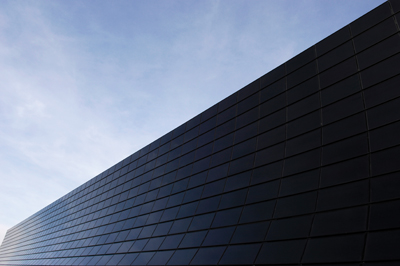 |
|
| Building Integrated Photovoltaics (BIPV) are solar modules that are integrated into the building during the design phase. Photo courtesy of Guardian.
|
If this trend becomes reality, conventional building materials in parts of the building envelope such as the roof and skylights will increasingly be replaced with photovoltaic materials. Building façades will no longer be plastered or covered in bricks or other materials in the foreseeable future as they are increasingly being used for energy generation.
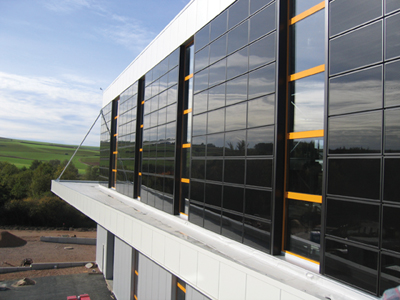 |
| The solar modules replace conventional building materials and the BIPV units function as an integral part of the building structure with the added value of generating electricity directly from sunlight. Photo courtesy of Guardian. |
The advantage of building integrated photovoltaics (BIPV) over more common non-integrated systems is that the initial cost can be offset by reducing the amount spent on building materials and labour that would normally be used to construct the part of the building that the BIPV modules replace. In addition, since BIPV systems are an integral part of the design, they generally blend in better and are more aesthetically appealing than other solar options. These advantages make BIPV one of the fastest growing segments of the photovoltaic industry.
Throughout Western Europe, particularly Germany, more projects than ever are incorporating BIPV. The practice has been experiencing relatively slow adoption in North America due to a long list of obstacles including size limitations, low light transmittance, lack of colours and tints, cost, availability, lack of government incentives, lack of education and information and geographical/climate performance.
Through strategic alliances and significant developments in the industry, manufacturers have made major breakthroughs such as the production of large format thin layer solar modules which are available for vision areas or in opaque colours for spandrel applications.
Thin is in
Advancements in thin film technology have made it possible to constantly exploit energy even without the presence of direct sunlight. Thin film technology is particularly interesting because glass is used as the base material and to cover the solar cells which is all laminated into a single lite of glass. The production methods are very similar to those used when producing laminated glass. The panels can be installed in a monolithic spandrel application or can be built into the outboard lite of a standard insulated glass unit.
Glass manufacturers like PPG and Guardian Industries have also presented new glass developments tailored to the needs of the solar industry such as low-iron, textured or specially coated glass.
The increasing use of BIPV modules as façade and roofing elements will change the kind of work demanded from glass fabricators, glazing contractors, architects, consultants and sub-contractors, although it is not going to happen in Canada overnight. However as the trend develops, conventional façade cladding will be replaced by solar modules so the skilled glazing trade will have to adapt to changes, in some geographical areas at least.
Konarka Technologies, Inc., an innovator in development and commercialization of Konarka Power Plastic, a material that converts light to energy, announced in April 2009 that the company has entered into an advanced product development agreement with Florida-based Arch Aluminum & Glass Co., Inc. to collaborate on BIPV.
Arch Aluminum, parent company of Mississauga, Ont.-based Trulite Industries, specializes in a wide range of artistic and architectural glass products for architects, designers and building developers. The company offers in house laminating, heat-treating and fabrication technology as well as selective, engineered, off-the-shelf aluminum and glass products.
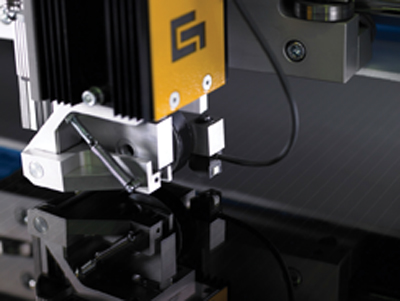 |
|
| Thin film technology is suited for glass machinery manufacturers because glass is used as the base material and to cover the solar cells. Photo courtesy of Grenzebach Maschinenbau GmbH.
|
In October 2008, Konarka opened the largest roll-to-roll flexible thin film solar manufacturing facility in the world, preparing for the commercialization and mass production of its solar material for various market segments including building and construction.
“The key to educating people about BIPV is that the one open area of attack from an energy resource side has always been the windows,” says Max Perilstein, vice-president of marketing, Arch Aluminum & Glass. “Low-E glass has made a huge impact on the glazing industry. The next frontier has been how to make those windows even better. And that is where PV and BIPV come along. Now, not only do you have the ability to have energy efficient windows, you also have the ability to draw energy from the sun and ambient light out of that glass and put it back into the building’s energy usage or sell it back to the grid,” he says. “And the key is now there is nothing being wasted in that building. Now the windows are really working one step further than they were before and are actively creating energy.”
Until recently, early generations of the PV cells have been very dark, either black or a dark grey. The material was not aesthetically attractive and did not give designers many options. However, that is now changing.
“With our technology partners Kanarka, we’ve been able to develop more aesthetically pleasing colours including red and green and we have a blue that is in production that will come out at the beginning of 2010. So now the design community has a variety of options that are easier to work with. They have a good visual option for BIPV that they’ve never had before and that will drive more people to be putting this on their facilities to make their windows more valuable.”
The next frontier
Perilstein says BIPV has struggled to take off in vision areas but it has gained some acceptance in spandrel areas. The key is whether the visible light transmittance is acceptable to the architectural community and building owners.
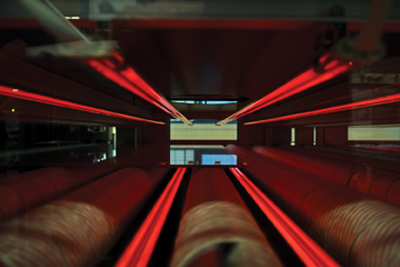 |
|
| Bystronic Armatec GmbH Glass Technology Centre’s pre-nip lamination system for pressing thin-film photovoltaic modules. Photo courtesy of Bystronic Glass Group (Bystronic Glass, Inc.). |
“It’s no different than having a ceramic frit dot pattern. When you are a few feet away from frit dot pattern, you don’t really notice the dots. And that is what we are working towards, to make this a very useable product.”
Perilstein explains that Arch is taking a proactive approach when working with the various stakeholders. “There’s no question there is some complexity to it; there will be some training involved. The average high end glazier has to deal with certain roadblocks and adventures every day. Especially companies that work with automated entrances or anything with electricity involved. They are dealing with wiring already. We’ll have to make sure that everyone is trained and ready. It’s not a real heavy duty electrical plan; you don’t need to a team of electricians to do it. The electrical will go to an inverter and the inverter will take care of pushing the energy to the right place. While it is complex, it is not an obstacle,” he says.
“The beautiful thing about this version of PV is that since you can see through it, you can put a high performance Low-E such as a Guardian SunGuard or PPG Solarban on the #3 surface and you have a very high performing insulated glass unit and you are also bringing energy into the building. It’s a great step forward for both Canada and the U.S. when we are both trying to improve our energy usages.”
The company received some feedback from the architectural community at the American Institute of Architects (AIA) national convention and design exposition in San Francisco, Calif., this year. “The reaction that we got from visitors to our booth was ‘Wow! We can see through this stuff;’ and that was exciting for us because that was the angle we were going for,” says Perilstein. “There is no question that this is the next frontier in the glass industry. Just like Low-E took a little while for people to get over the skepticism, we’re going to have that with this product too. There will be skepticism. I also think that in the long-run it will have the same or more success than we are experiencing with Low-E right now.”
Latitude dependant
Another visionary in the glass industry, Guardian Industries, recognizes the opportunity for BIPV. The company has partnered with a European producer of semi-conductor plates who utilizes Guardian’s EcoGuard glass to manufacture the panels. Scott Thomsen, chief technology officer of Guardian Industries,
explains overcoming some of the challenges that the company has faced bringing BIPV to market. “The current photovoltaic module size is not big enough to support a lot of the large window openings. We have developed a process of tiling multiple semi-conductor plates onto a bigger piece of glass. We do the tiling process and the electrical interconnect for the unit that goes into the façade. Guardian is at both the beginning and the end of the chain.”
Thomsen sees opportunity with BIPV; however, he is also careful to note that the technology is still in its market infancy. “There are so many unknowns regarding the technology and its use in an integrated skin design. Think about the whole channel. When an architect designs a building today, he doesn’t worry about electrical generation. So if they put them in, they want to know how much energy is being generated and what to do with that energy, and how to tie that electricity into the whole building network. It increases the complexity of the design phase of the building,” he says.
“There are always the trophy projects. Like the Grand Central Station in New York, where they put BIPV in, but the glass was provided for free. Most of the jobs where it has been legitimately integrated into the building have been in Europe. That is the primary epicenter right now,” he says, adding the biggest challenge in Europe has been the education of the architects and glaziers. “We need to make it easy for the architectural façade chain to specify, purchase and install BIPV. Once that happens, you’re going to see the demand increase.”
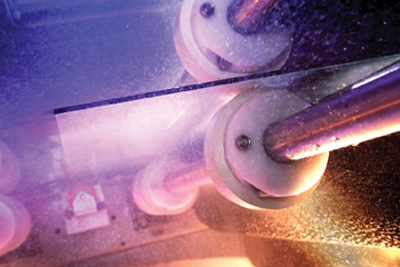 |
|
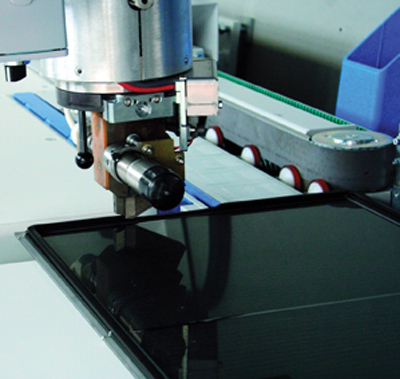 |
|
| Bystronic’s TPS applicator for encapsulating filmless thin layer modules and its Glass Plate Washing Machine GW-D, used in the production of thin-layer modules were showcased at the Photovoltaic Technology Show 2009. Photos courtesy of Bystronic Glass Group (Bystronic Glass, Inc.).
|
In parallel is the economic analysis. BIPV is latitude dependant. As you get closer to the equator, the payback is shorter. As you get farther from the equator, the payback is less. However, if they are doing it in Germany, they should be able to make it work in Canada. Why does it work in Germany?
“There are government incentives for capital purchases and feed-in tariffs. They get paid more for power they put into the grid than they take out,” explains Thomsen. “Their governments are providing incentives and that reduces the payback period. In the U.S., and Canada, our governments need to get involved for PV to take off. They are going to have to offer some incentives. With the current efficiency and dollar per watt generated, you can make it work but it’s close. So as the costs of the modules go down and the efficiency of the cells goes up, it’s going to keep pulling in that payback period. And then you’re going to see a greater increase in demand.”
He says Guardian Industries is already promoting it to the architectural community and is currently in the testing and certification process. “We are out there trying to work with architects trying to get BIPV designed and specified into commercial buildings right now.”
Thomsen is cautious not to over promise and under deliver, “Could we do 20 projects today? No. Right now our main goal is to develop the infrastructure to make it easier to get it installed and then we have to start getting more data on payback and benefits for building owners.”
Made in Canada
In 2002, Busby Perkins+Will’s Telus House project in British Columbia won first place in Glass Canada magazine’s Great Canadian Curtainwall Contest. The Telus House project was conceived to satisfy a number of internal business needs and, in doing so, revitalized an existing complex and created a powerful corporate presence for the company in downtown Vancouver. The project consisted of two major phases: an extensive renovation of the former building into office and retail space, and the creation of a feature atrium for team members that serves as a seismic upgrade for the building.
The first phase of Telus House included extensive interior and exterior renovations of approximately 12,075 square metres of office and equipment space. Instead of demolishing the existing nine-storey tower, Telus and the design team devised an alternative solution: to recycle the building into offices and, in turn, save landfill, energy and other resources.
The exterior revitalization was realized as an open, layered and sophisticated new skin enveloping the old building shell. A double-glazed, fritted and frameless glazing system with operable windows is suspended from the existing building face, providing opportunities for a highly effective natural ventilation system. The second skin created the first double-wall/triple-skinned green building solution in Canada, while adhering to the Telus ultra-green mandate.
By not demolishing the existing building in favour of new construction, 16,000 tonnes of landfill and 15,600 tonnes of greenhouse gas (GHG) emissions were saved. Yearly energy consumption has been reduced by 45-58 per cent by using waste heat from an adjacent building, and efficient building systems operations will save an additional 39,000 tonnes of GHG emissions over a 75-year building lifespan. In recognition of its innovations in environmental performance, the Telus House revitalization was one out of three projects selected to represent Canada at the Green Building Challenge in Maastricht, Netherlands.
Jim Huffman, the associate principal and design principal on Telus House explains how the firm successfully incorporated BIPV into the project. “We suspended a curtainwall about a meter out from the brick wall for cleaning as opposed the thermal control. This glass wall was nine stories tall by about 100 feet wide and at the top there are ventilators so in the summer, Telus can open the ventilators and flush the air out to keep the building cool. In the winter they close the ventilators. It’s like putting a jacket on the building and it helps to warm the building,” he says.
The fans at the top sucking the air out are powered by the BIPV built into some of the glass panels near the top of the building. The fans run at 12 volts and the panels provide 12 volts so they do not have to go through an inverter. The sun shines on the PV and the energy drives the motors for the fans to suck the air out.
“There’s a row at the top on two sides of the building that have BIPV. They look just like other glass windows except if you look closely you can tell there is something different going on there,” says Huffman. “The typical glass is double glazed. In some cases there are frit patterns to reduce solar energy to some of the rooms. Where the PV panels are, it is still double glazed but a little thicker due to the laminated lites with the PV cells. There are lots of buildings with laminated glass so it’s just something else you throw in there. The PV pieces were around five or six inches square. We didn’t put them right tight together, we spaced them a half to one inch apart from one another so light would transmit through them. There weren’t any windows behind them, so they weren’t vision glass. We placed them so they would provide some shading of the windows below. Instead of putting frit on that portion we just used them as the shading device.”
BIPV as a design element
He says Burnaby, B.C.-based Advanced Glazing Systems did all the glazing and the glass with the PV laminating came from Germany. “At the time that was a bit of a push and it cost a fair amount, but PV always costs a lot. The only problem that we had was that this glass was in the vertical plane. The sun is coming from all different angles depending on the time of day. Normally when you put a PV panel on a roof, you have it almost horizontal or a steep angle. These were straight up and down and there are some taller buildings going in there now. Later in the day they are probably getting more shade than we had initially anticipated. Getting BIPV panels so they actually catch the sun can be a problem in an urban setting,” he says.
Most PV in buildings is roof mounted, but BIPV allows it to be integrated as part of the building so it does not look like it was tacked on. “It’s a great method since you have to put the glazing up anyway, but you still want to tilt it to the proper solar angles so you maximize the amount of energy created such as in skylights,” he says.
Huffman believes the challenges with designing BIPV are easily overcome. “I think you can make it look good. I’ve seen some buildings where the designer has used BIPV as the design element. I’ve seen people take advantage of it. You can’t really hide it because it needs to be fully exposed to the sun.”
Again, economic value will depend upon the building’s geographic location, more sunshine means a bigger payback. “Places like Calgary and the Prairies would be better suited; regions where it doesn’t rain as much would have the best return on investment. If you get twice as much sun, you are going to get twice as much energy,” he says. “Just for standard off the shelf roof mount units, people are now talking around a 25 year payback period. Whereas the integrated ones are another price range so it takes longer to pay those back. But if you can say that BIPV is part of my cladding and shading system and I don’t have to put frit on them, you might be able to justify the costs because it is doing more than just providing power, it is also providing shading. And if more North American experience can be developed, costs will go down and the technology will catch on.”
Walk into any Canadian Tire across the country and you will find a variety of photovoltaic products. In fact, this article was completed on a notebook computer powered by photovoltaics at rural cottage over the Victoria Day long weekend. There is no question that there is still a lot of work to be completed before BIPV will become mainstream in building designs, however, the key players in BIPV are rapidly advancing their research and development of this technology, lobbying governments for incentives and educating stakeholders.
If the trend of sustainable design continues as it is forecasted, BIPV has the potential to be as widely utilized as any other type of high performance glass product available on the market.
*Rich Porayko is a professional writer and founding partner of Construction Creative, a marketing and communications company located in Metro Vancouver, B.C. richp@constructioncreative.com
Print this page
Leave a Reply